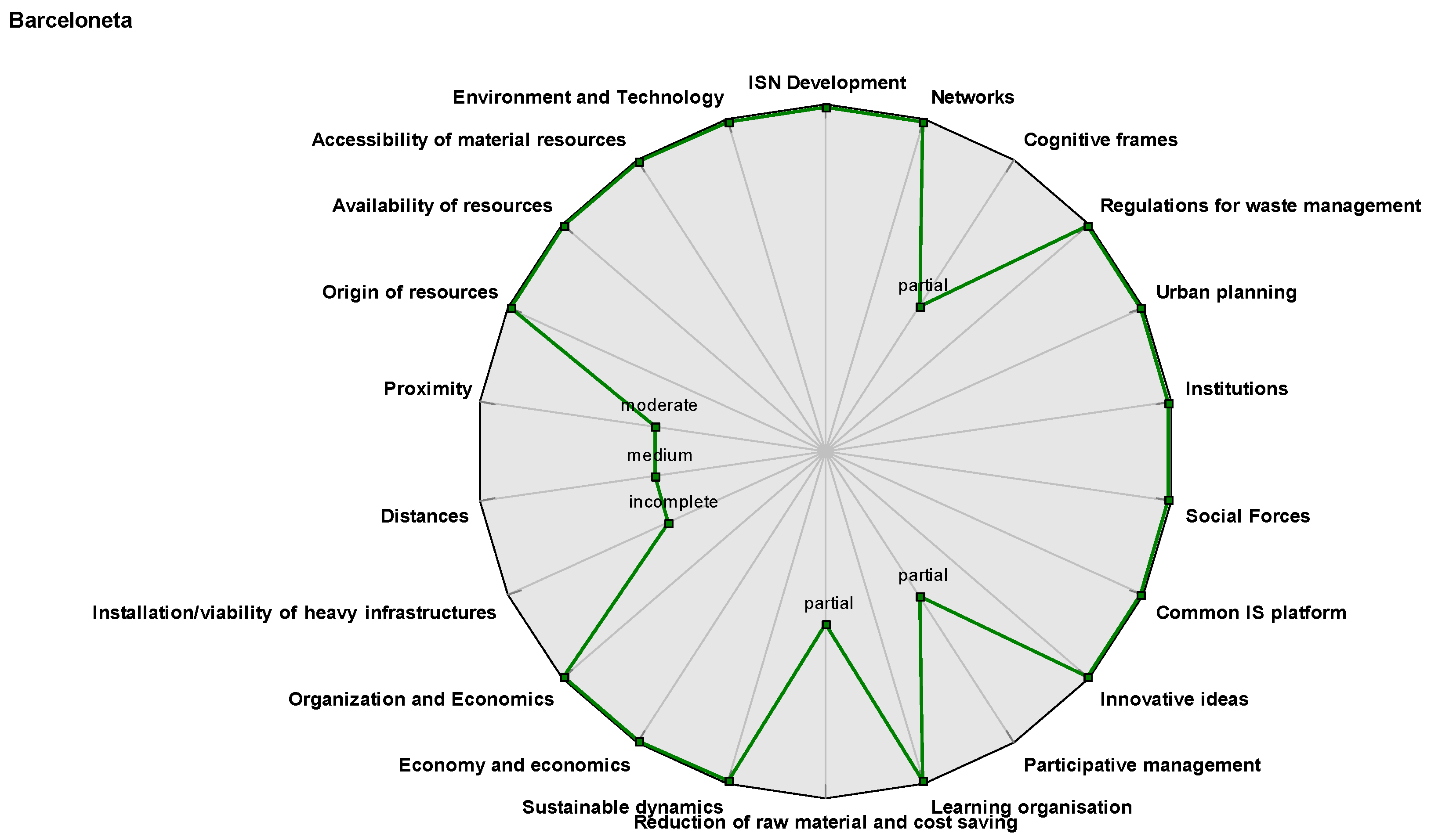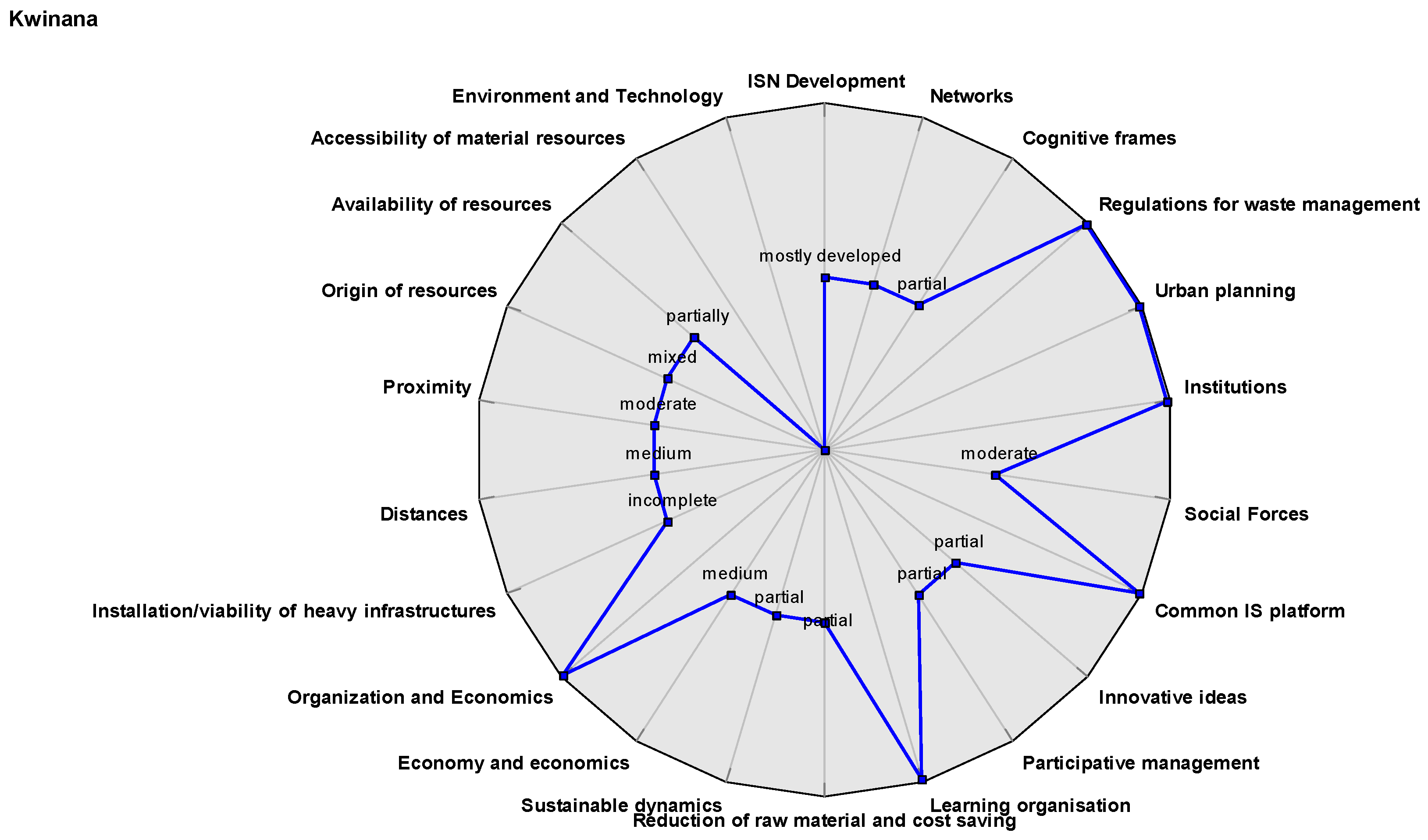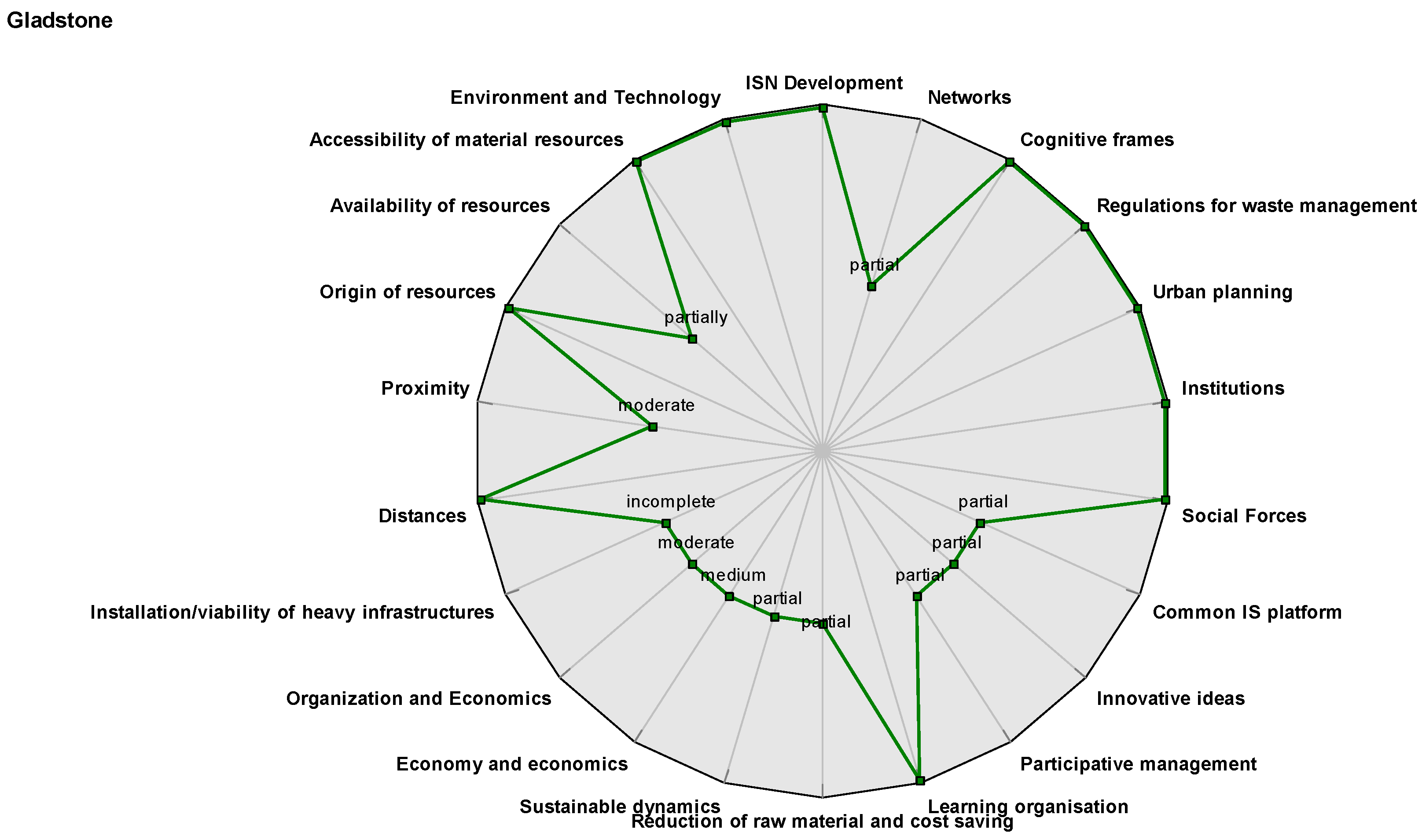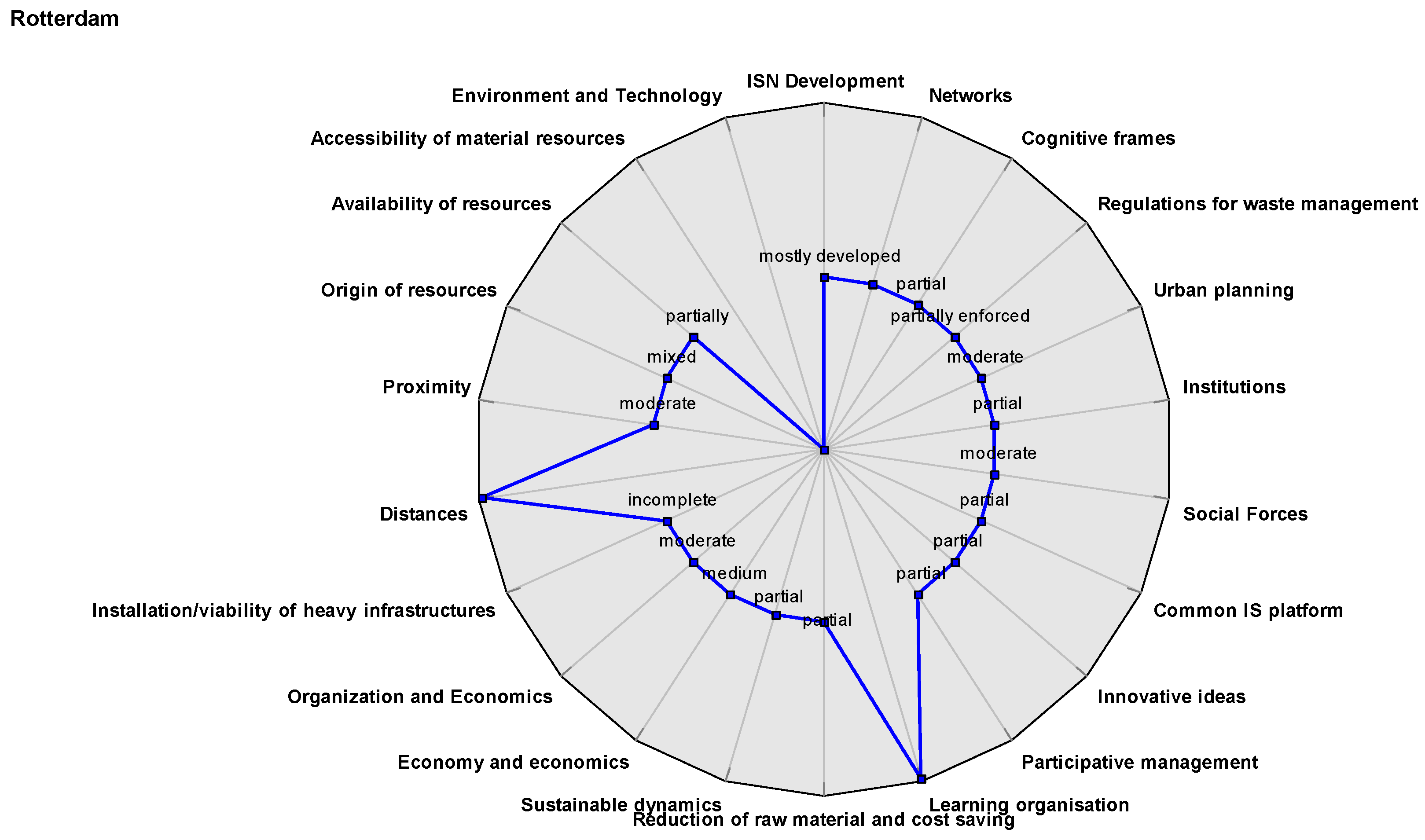Modeling and Evaluation of the Possibilities of Forming a Regional Industrial Symbiosis Networks †
Abstract
:1. Introduction
2. Materials and Methods
- Definition of the relevant attributes for three spheres: environmental and technological, organizational and economy, and social. The result was an ordered list of all 22 (13 + 9) attributes.
- Developing attributes’ hierarchy based on their interrelations and anticipated influence on the final proposed outcomes of the model. The process involved structuring, comparing, and aggregating the list of attributes using a “bottom-up” approach.
- Implementation of the attribute hierarchy into a DEXi model. The result of this stage is the tree of attributes given in Table 1.
- Definition of attributes’ measurement scales and set of values that each attribute may obtain. The DEX method is a qualitative one and usually represents attributes whose values are represented by words, such as “impossible,” “incomplete,” or “possible “or other (see Table 1, column 2).
3. Modeling Results: Options Description End Evaluation
3.1. ISN in Kalundborg
3.2. ISN in Aalborg
3.3. ISN in Guayama
3.4. ISN in Barceloneta
3.5. ISN in Kwinana
3.6. ISN in Gladstone
3.7. ISN in Rotterdam
4. Discussion and Conclusions
Author Contributions
Conflicts of Interest
Appendix A. Description of Attributes
- High availability of water resources in the area.
- Existing exchanges and reuse of different types of waste flows among firms.
- There is an availability of critical resources such as energy, or particular raw materials.
- There are public and private benefits shown as “spontaneous co-location” (Chertow 2007) of businesses in industrial districts, to give rise to numerous public, and private benefits including labor availability, access to capital, technological innovation, and infrastructure efficiency.
- Availability of close port/s that are used for acquiring resources.
- Availability of industrial land.
- Impacts of distance when making decisions among firms.
- Metric distances between major cities and industrial centers in regional area.
- IS project does not have significant limitations of viability of transporting certain types of resources over long distances (such as steam or heat).
- Sharing of access of heavy infrastructures (such as new waste exchange systems relying on pipeline or other heavy infrastructures; extensive roads, rails and port infrastructures to allow for reliable transport) is in place (to reduce atmospheric emissions).
- Geographical dispersion of firms enforces laws and regulatory codes
- Firms have an agreement to share the use of the installations.
- The region has potential for renewable energy to a region’s (country) natural capabilities.
- There is a possibility for installation of heavy visible infrastructures.
- A firm’s objectives are directed towards sustainable developments for the IS to have success.
- Sustainable dynamism in the firms includes integrated policy, planning, and social learning processes.
- Sustainable dynamics and objectives are successfully managed to be integrated in the policy programs of government.
- Sustainable objectives are achieved by practical implementation of sustainable principles—decision-making processes.
- Re-use of raw material can significantly reduce the industry vulnerability with regard to raw material scarcities (for example water, greenhouse gases).
- Initiatives are put in place to resolve the reduction of raw material and cost saving situation.
- Providing real value of the money to the firm in some way, such as through cost savings or increased revenue.
- Implementation of collaborative technologies for reduction, reuse, and recycling of raw material.
- Accumulated know-how developed through long experiences and relationships of employees.
- Sharing of information and know-how among employees.
- Collaboration and dialogue in firms resulted in new ideas.
- Encouraging creativity and innovation of employees.
- Common cooperation is associated with development of ISNs of cooperative relationships between people, acting essentially as individuals, exchanging ideas, knowledge and advices in firms.
- Firms considerate the order to further employee’s efforts to improve, make progress and evolution in the environmental performance of the organization they represent.
- Existing institutional platforms and linkages, communication and trust, coordination.
- Comprehensible databases; both existing and potential businesses can easily identify possible synergistic connections.
- The available inventory and assessment of potential symbiotic connections (Rehn 2013).
- Existence of a controlled rural urban migration, urbanization with proper planning, and rapid industrialization with good infrastructure.
- Existence of an on-site waste management plans.
- Proper planning for required material quantities, on time passing of information on types and sizes of materials and components to be used.
- Good supervision of the urban planning (Letcher and Vallero 2011).
- Exists a governmental action and commitment for reform towards green growth.
- Emergence of a variety of Eco-innovations as a result of regulatory and market-based instruments.
- Enforcement of environmental taxes and regulations on harmful substances.
- A literature evidence that government regulations and liability concerns are one of the reasons for action in developing synergy initiatives.
- The changes of environment may lead to marginalization of the firms in cases when firms are not adaptable to the changes.
- Some insights are present on the interrelation and dynamics among cognitive frames and other two social forces.
- Highly innovative solutions that alter cognitive frames might outweigh long-established institutional incentives like tax exemptions.
- There are present and implemented sanctions that are aimed to foster the integration of persons into the employment force in IS.
- Sheared meaning structures might be incorporated in the notion of institution and therefore cognitive frames are not explicitly distinguished (Beckert 2010).
- Number of different public sectors or actors that can support IS developments in different ways.
- Network is considered strong if public sector can set ambitious local policies demanding improved waste management and/or reduced emissions, creating the context for symbiotic exchanges.
- Public sector can influence on the highly effective relationships and information brokers, by creating vital conditions for communication, familiarity, and trust among regional actors in IS.
- The planning in IS, and procurement functions can also be adapted to create more fertile contexts for the development of ISNs.
- Networks can support or hinder symbiotic relationships relevant to ISNs, with focus on the influence of the policy framework like the nature of inter-firm business models and governance mechanisms; and the role of public–private partnerships (Granovetter 1985).
- IS networks being “embedded” (Baas and Huisingh 2008; Kalundborg Symbiose 2017) in social systems and, as such, decision-making processes are shaped by social relations (regulation systems, trust, beliefs, and knowledge are crucially influencing the direction and management of physical exchanges) (Jacobsen 2005; Jacobsen and Anderberg 2005).
Appendix B. Utility Functions






References
- Aalborg Industries. 2017. Available online: http://www.energy-oil-gas.com/2008/04/09/aalborg-industries/ (accessed on 20 October 2017).
- Aalborg Kommune. 2010. En Lokalplans Forløb i Aalborg Kommune. Available online: http://www.aalborg.dk/ (accessed on 26 October 2017).
- Almasi, Alexandra Maria, Soque Cecilia, Kirk Strandgaard Christoffer, and Sacch Romain. 2011. Modeling Industrial Symbiosis-Aalborg East (Denmark) Case: Sustainability. Human Impact on the Environment. Available online: https://slidedocument.org/modeling-industrial-symbiosis-aalborg-east-denmark-case (accessed on 30 October 2017).
- Ashton, Weslynne S. 2008. Understanding the organization of industrial ecosystems-A social network approach. Journal of Industrial Ecology 12: 34–51. [Google Scholar] [CrossRef]
- Ayres, Robert U., and Leslie Ayres. 2002. A Handbook of Industrial Ecology. Cheltenham: Edward Elgar Publishing. [Google Scholar]
- Baas, Leo. 2008. Industrial symbiosis in the Rotterdam Harbor and Industry Complex: reflections on the interconnection of the techno-sphere with the social system. Business Strategy and the Environment 17: 330–40. [Google Scholar] [CrossRef]
- Baas, Leo. 2011. Planning and uncovering industrial symbiosis: Comparing the Rotterdam and Östergötland regions. Business Strategy and the Environment 20: 428–40. [Google Scholar] [CrossRef]
- Baas, Leo W., and Don Huisingh. 2008. The Synergistic Role of Embeddedness and Capabilities in Industrial Symbiosis: Illustration Based upon 12 Years of Experiences in the Rotterdam Harbor and Industry Complex. Progress in Industrial Ecology, an International Journal 5: 399–421. [Google Scholar] [CrossRef]
- Beckert, Jens. 2009. The Social Order of Markets. Theory and Society 38: 245–69. [Google Scholar] [CrossRef]
- Beckert, Jens. 2010. How Do Fields Change? The Interrelations of Institutions, Networks, and Cognition in the Dynamics of Markets. Organization Studies 31: 605–27. [Google Scholar] [CrossRef]
- Black Sea Industrial Symbiosis Platform. 2017. European MSP Platform. January 9. Available online: http://msp-platform.eu/practices/black-sea-industrial-symbiosis-platform (accessed on 15 October 2017).
- Boshkoska, Biljana Mileva, Rončević Borut, and Džajić Uršič Erika. 2017. Decision making process for appropriateness of industrial symbiosis-based to industrial symbiosis networking. Paper presented at the 9th Slovenian Social Science Conference on Social Transformations: The Global and the Local-Transformations towards Sustainable Economy, Ljubljana, Sloven, 21 September. [Google Scholar]
- Cavallo, Marino, Degli Esposti Piergiorgio, Konstantinou Kostas, Nemac Franko, M. Battaglia, F. Iraldo, R. Paltrinieri, I. Sarigiannis, P. Mikelopoulou, A. Cecchin, and et al. 2012. Priročnik za Zeleno Komuniciranje in Marketing. Translated by Franko Nemac. Ljubljana: ApE-Agencija za Prestrukturiranje Energetike. [Google Scholar]
- Chertow, Marian R. 2000. Industrial Symbiosis: Literature and Taxonomy. Annual Review Energy Environment 25: 313–37. [Google Scholar] [CrossRef]
- Chertow, Marian R. 2007. Uncovering Industrial Symbiosis. Journal of Industrial Ecology 11: 11–30. [Google Scholar] [CrossRef]
- Chertow, Marian R., and Rachel D. Lombardi. 2005. Quantifying Economic and Environmental Benefits of Co-Located Firms. Environmental Science & Technology 39: 6535–41. [Google Scholar]
- Cohen-Rosenthal, Edward, and Judy Musnikow. 2003. Eco-Industrial Strategies-Unleashing Sinergy between Economic Development and the Environment. Sheffield: Greenleaf Pub. [Google Scholar]
- Corder, Glen D. 2006. Interim Report on Long-Term Initiatives for Large Waste Streams in the Gladstone Region: Project 3C1. Brisbane: Centre for Social Responsibility in Mining, Sustainable Minerals Institute, The University of Queensland. [Google Scholar]
- Corder, Glen D., Golev Artem, Fyfe Julian, and King Sarah. 2014. The Status of Industrial Ecology in Australia: Barriers and Enablers. Resources 3: 340–61. [Google Scholar] [CrossRef]
- Costa, Inês Massard G., and Paulo Ferrão. 2010. A Case Study of Industrial Symbiosis Development Using a Middle-out Approach. Journal of Cleaner Production 18: 984–92. [Google Scholar] [CrossRef]
- Costa, Inês, Massard G, and Abhishek Agarwal. 2010. Waste management policies for industrial symbiosis development: case studies in European countries. Journal of Cleaner Production 18: 815–22. [Google Scholar] [CrossRef]
- CRESSI Publications Saïd Business School No. 5. 2015. Taking Action for Social Innovation. Available online: https://www.sbs.ox.ac.uk/facultyresearch/research-projects/creating-economic-space-social-innovation-cressi/cressi-publications (accessed on 26 October 2017).
- Criado Pacheco, Natalia, Carlos Carrascosa, Nardine Osman, and Vicente Julián Inglada. 2017. Multi-Agent System and Agreement Technologies. Paper presented at the 14th European Conference, EUMAS 2016, and 4th International Conference, AT 2016, Valencia, Spain, 15–16 December. [Google Scholar]
- CTTÉI. 2013. Centre de Transfert Technologique en Écologie Industrielle, Creating an Industrial Symbiosis. Available online: https://jocelyndaneaudotorg.files.wordpress.com/2016/01/cttei-planifstrat-2010-2015.pdf (accessed on 20 October 2017).
- Deutz, Pauline. 2014. Food for Thought: Seeking the Essence of Industrial Symbiosis. In Pathways to Environmental Sustainability Methodologies and Experiences. Edited by Roberta Salomone and Giuseppe Saija. Cham: Springer, pp. 3–13. [Google Scholar]
- DEXi: A Program for Multi-Attribute Decision Making. 2017. Available online: http://kt.ijs.si/MarkoBohanec/dexi.html (accessed on 26 October 2017).
- Doménech Aparisi, Teresa. 2010. Social Aspects of Industrial Symbiosis Networks. Ph.D. dissertation, Barlett School of Graduate Studies, University College London, London, UK; pp. 19–25. Available online: http://discovery.ucl.ac.uk/762629/ (accessed on 26 October 2017).
- Doménech Aparisi, Teresa, and Michael Davies. 2011. Structure and Morphology of Industrial Symbiosis Networks: The Case of Kalundborg. Procedia-Social and Behavioural Scien ces 10: 79–89. [Google Scholar] [CrossRef]
- Ehrenfeld, John, and Nicholas Gertler. 1997. Industrial Ecology in Practice: The Evolution of Interdependence at Kalundborg. Journal of Industrial Ecology 1: 67–80. [Google Scholar] [CrossRef]
- Eilering, Janet A. M., and Walter J. Vermeulen. 2004. Eco-industrial parks: Toward industrial symbiosis and utility sharing in practice. Progress in Industrial Ecology 1: 245–70. [Google Scholar] [CrossRef]
- Fligstein, Neil. 2002. The Architecture of Markets: An Economic Sociology of Twenty-First-Century Capitalist Societies. Princeton: Princeton University Press. [Google Scholar]
- Fric, Urška, and Borut Rončević. Forthcoming. Putting ‘the Social’ in Industrial Symbiosis Networks in Their Place: Debates and Research Trends. Novo Mesto: Faculty of Information Studies.
- Gingrich, Craig. 2012. Industrial Symbiosis: Current Understanding and Needed Ecology and Economics Influences. Policy Engagement. Toronto: Centre for Engineering and Public Policy, pp. 44–49. [Google Scholar]
- Gladstone Industry Leadership Group. 2017. Available online: https://gilg.com.au/ (accessed on 26 October 2017).
- Gladstone Synergies Project 3C1 Final Report-2008_06_06. Pdf. 2008. Available online: http://www.csrm.uq.edu.au/docs/Gladstone%20Synergies%20Project%203C1%20Final%20Report%20-%202008_06_06.pdf (accessed on 26 October 2017).
- Golev, Artem, Corder Glen D, and Giurco Damien P. 2014. Industrial symbiosis in Gladstone: A decade of progress and future development. Journal of Cleaner Production 3: 340–61. [Google Scholar] [CrossRef]
- Granovetter, Mark. 1985. Economic Action and Social Structure: The Problem of Embeddedness. American Journal of Sociology 91: 481–510. [Google Scholar] [CrossRef]
- Harris, Steve. 1987. The Potential Role of Industrial Symbiosis in Combating Global Warming. Available online: http://www.hkccf.org/download/iccc2007/30May/S3B/Steve%20HARRIS/The%20Potential%20Role%20of%20Industrial%20Symbiosis%20in%20Combating%20Global%20Warming.pdf (accessed on 26 October 2017).
- Hartard, Sussane. 2008. Industrial Ecology and Industrial Symbiosis: New Concepts or New Branding? Trier: Trier University of Applied Sciences—Umwelt-Campus Birkenfeld, Available online: http://www.up.edu.br/cmspositivo/uploads/imagens/files/Mestrado%20Gest%C3%A3o%20Ambiental/summer%20school/Hartard%20-%20%20Industrial%20Ecology.pdf (accessed on 2 October 2017).
- Henriksen, Anne Bomann, Amanda Hill, Davide Cassanmagnago, Desislava Kavaldzhieva, Janalisa Franzi Hahne, and Jorgen Hugo Jensen. 2013. EMSS Master Project Industrial Symbiosis in Aalborg Study Case: Network 9220. Available online: http://man-in-nature.dk/IS/Henriksen_et_al_2013_IS_in_Aalborg_revised_version.pdf (accessed on 26 October 2017).
- Howard-Grenville, Jennifer, and Raymond Paquin. 2008. Organizational Dynamics in Industrial Ecosystems: Insights from Organizational Theory. In Dynamics of Industrial Ecosystems. Edited by Matthias Ruth and Brynhildur Davidsdottir. Campberley: Edvard Elgar, pp. 157–75. [Google Scholar]
- Jacobsen, Noel. 2005. Industrial symbiosis in the making: Bridging social and technical explanations—The case of Kalundborg, Denmark. Paper presented at the 11th Annual International Sustainable Development Research Conference, Helsinki, Finland, 6–8 June. [Google Scholar]
- Jacobsen, Noel, and Stefan Anderberg. 2005. Understanding the evolution of industrial symbiotic networks: The case of Kalundborg. In Economics of Industrial Ecology: Materials, Structural Change, and Spatial Scales. Edited by J. C. J. M. Van den Bergh and Janssen M. Cambridge: MIT Press. [Google Scholar]
- Jereb, Eva, Bohanec Marko, and Rajkovič Vladislav. 2003. Dexi: Računalniški Program za Večparametrsko Odločanje: Uporabniški Priročnik. Kranj: Moderna Organizacija, ([Medvode]: Fleks). [Google Scholar]
- Kalundborg Symbiose. 2017. Kalundborg Symbiose-Verdens Første Industrisymbiose. Available online: http://www.symbiosis.dk/ (accessed on 26 October 2017).
- Laybourn, Peter. 2015. Industrial Symbiosis: Delivering Resource Efficiency and Green Growth. Birmingham: International Synergies. Available online: http://www.international-synergies.com/wp-content/uploads/2015/10/G7-Laybourn-International-Synergies.pdf (accessed on 26 October 2017).
- Leigh, Michael, and Xiaohong Li. 2015. Industrial Ecology, Industrial Symbiosis and Supply Chain Environmental Sustainability: A Case Study of a Large UK Distributor. Journal of Cleaner Production 106: 632–43. [Google Scholar] [CrossRef]
- Letcher, M. Trevor, and Daniel Vallero. 2011. Waste: A Handbook for Management. Cambridge: Academic Press. [Google Scholar]
- Novokovic, Ana, Chobanova M. Hristina, Kubilius Tadas, Mäkitie Tuukka, Serebrjakova Lasma, Deng Yang, and Wenyang Zhao. 2012. Environmental Cooperation in Erhvervs Netværk 9220. Aalborg: Aalborg University, Semester Project. [Google Scholar]
- Phillips, Paul S., Barnes Richard, Bates Margaret P, and Coskeran Thomas. 2005. A Critical Appraisal of an UK County Waste Minimisation Programme: The Requirement for Regional Facilitated Development of Industrial Symbiosis/Ecology. Resources, Conservation and Recycling 46: 242–64. [Google Scholar] [CrossRef]
- Rehn, Sofia. 2013. Influencing Industrial Symbiosis Development: A Case Study of Händelö and Northern Habour Industrial Areas. Master dissertation, Linköping University, The Institute of Technology, Linköping, Sweden. Available online: https://www.diva-portal.org/smash/get/diva2:629831/FULLTEXT02.pdf (accessed on 3 December 2017).
- Rui, Jiali, and R. Reinout Heijungs. 2010. Industrial Ecosystems as a Social Network, Knowledge Collaboration & Learning for Sustainable Innovation. Paper presented at the ERSCP-EMSU Conference, Delft, The Netherlands, 25–29 October. [Google Scholar]
- Schiller, Frank, S. Penn Alexandra, and Basson Lauren. 2014. Analyzing Networks in Industrial Ecology—A Review of Social-Material Network Analyses. Journal of Cleaner Production 76: 1–11. [Google Scholar] [CrossRef] [Green Version]
- Scrase, James, Stirling Andy, Geels Frank, Adrian Smith, and Van Zwanenberg Patrick. 2009. Transformative Innovation: A Report to the Department for Environment, Food, and Rural Affairs. Brighton: University of Sussex. [Google Scholar]
- Shi, Han, Marian R. Chertow, and Song Yuyang. 2010. Developing country experience with Eco-industrial parks: A case study of the Tianjin Economic-Technological Development Area in China. Journal of Cleaner Production 18: 191–99. [Google Scholar] [CrossRef]
- Social Constructionism. 2016. Available online: https://en.wikipedia.org/wiki/Social_constructionism/ (accessed on 10 February 2016).
- Steward, Fr. 2008. Breaking the Boundaries: Transformative Innovation for the Global Good. London: NESTA. [Google Scholar]
- Symbiosis. 2010. Siden Blev Ikke Fundet. Available online: http://www.symbiosis.dk/sites/48 (accessed on 20 February 2017).
- Talent. 1997. Ekspertni Sistem za Usmerjanje Otrok in Mladine v Športne Panoge. Available online: http://kt.ijs.si/MarkoBohanec/pub/Talent1997.pdf (accessed on 26 October 2017).
- Uzzi, Brian. 1996. The sources and consequences of embeddedness for the economic performance of organizations: The network effect. American Sociological Review 61: 674–98. [Google Scholar] [CrossRef]
- Van Beers, Dick, Glen David Corder, Albena Bossilkov, and Rene Van Berkel. 2006. Regional Synergies in the Australian Minerals Industry: Case-Studies and Enabling Tools. Minerals Engineering 20: 830–41. [Google Scholar] [CrossRef]
- Velenturf, Anne, and Paul D. Jensen. 2015. Promoting Industrial Symbiosis: Using the Concept of Proximity to Explore Social Network Development. Journal of Industrial Ecology 20: 700–9. [Google Scholar] [CrossRef] [Green Version]
- Zhu, Qinghua, Lowe A. Ernest, Wei Yuan-an, and Barnes Donald. 2007. Industrial Symbiosis in China: A Case Study of the Guitang Group. Journal of Industrial Ecology 11: 31–42. [Google Scholar] [CrossRef]








| Attribute | Scale | Description |
|---|---|---|
| ISN Development | Partially developed; mostly developed; fully developed | Current ISN Development |
| ├─ Environment and Technology | Weak; moderate; strong | Facets, location, diversity of industries, presence of river, sea, core businesses |
| │ ├─ Accessibility of material resources | Low; moderate; satisfying | Scarcity of resources |
| │ ├─Availability of resources | No; partially; yes | Industrial water, energy, production materials (primary and secondary) |
| │ └─Origin of resources | External; mixed; internal | How the available resources are connected: internal, external, mixed |
| │ └─ Proximity | Low; moderate; satisfying | Physical distance among industrial installations |
| │ ├─Distances | Long; medium; short | Distances among firms |
| │ └─Installation/viability of heavy infrastructures | Impossible; incomplete; possible | Vicinity of the main infrastructure suppliers to the IS area |
| ├─ Organization and Economics | Low; moderate; satisfying | Economic benefits, profitability |
| │ ├─ Economy and economics | Low; medium; high | Yielding the benefits of industrial symbiosis |
| │ │ ├─Sustainable dynamics | Weak; partial; strong | Create economic growth, while advancing social and environmental objectives |
| │ │ └─Reduction of raw material and cost saving | Weak; partial; strong | Reduction, reuse and recycling; Income generating synergies |
| │ ├─ Learning organization | Low; moderate; satisfying | An approach to include innovative ideas of employees in the decision making process |
| │ │ ├─Participative management | Weak; partial; strong | Involvement of employees into decision making processes |
| │ │ └─Innovative ideas | Weak; partial; strong | Employees generate innovative ideas |
| │ └─Common IS platform | No; partial; yes | Existence of a joint and comprehensive policy and communication platform |
| └─ Social Forces | Low; moderate; satisfying | Social factors shaping the topography of IS networks |
| ├─ Institutions | Weak; partial; strong | Rules, ritualized behaviours |
| │├─Urban planning | Low; moderate; satisfying | Local and/or regional spatial planning |
| │ └─Regulations for waste management | Weakly enforced; partially enforced; fully enforced | Implementation of the waste management regulations |
| ├─Cognitive frames | Weak; partial; strong | Green values, public awareness and green procurement |
| └─Networks | Weak; partial; strong | Social trust and ease of cooperation |
| Attribute | Kalundborg | Aalborg | Guayama | Barceloneta | Kwinana | Gladstone | Rotterdam |
|---|---|---|---|---|---|---|---|
| ISN Development | fully developed | mostly developed | mostly developed | fully developed | mostly developed | fully developed | mostly developed |
| ⊢─ Environment and Technology | strong | strong | weak | strong | weak | strong | weak |
| │ ⊢─ Accessibility of material resources | satisfying | satisfying | low | satisfying | low | satisfying | low |
| │ │ ⊢─Availability of resources | partially | partially | partially | yes | partially | partially | partially |
| │ │ └─Origin of resources | internal | internal | mixed | internal | mixed | internal | mixed |
| │ └─ Proximity | moderate | moderate | moderate | moderate | moderate | moderate | moderate |
| │ ⊢─Distances | short | short | medium | medium | medium | short | short |
| │ └─Installation/viability of heavy infrastructures | incomplete | incomplete | incomplete | incomplete | incomplete | incomplete | incomplete |
| ⊢─ Organization and Economics | satisfying | moderate | satisfying | satisfying | satisfying | moderate | moderate |
| │ ⊢─ Economy and economics | medium | medium | high | high | medium | medium | medium |
| │ │ ⊢─Sustainable dynamics | partial | partial | strong | strong | partial | partial | partial |
| │ │ └─Reduction of raw material and cost saving | partial | partial | partial | partial | partial | partial | partial |
| │ ⊢─ Learning organization | satisfying | satisfying | satisfying | satisfying | satisfying | satisfying | satisfying |
| │ │ ⊢─Participative management | partial | strong | partial | partial | partial | partial | partial |
| │ │ └─Innovative ideas | partial | partial | partial | strong | partial | partial | partial |
| │ └─Common IS platform | yes | partial | partial | yes | yes | partial | partial |
| └─ Social Forces | satisfying | moderate | moderate | satisfying | moderate | satisfying | moderate |
| ⊢─ Institutions | strong | partial | partial | strong | strong | strong | partial |
| │ ⊢─Urban planning | satisfying | moderate | satisfying | satisfying | satisfying | satisfying | moderate |
| │ └─Regulations for waste management | fully enforced | partially enforced | partially enforced | fully enforced | fully enforced | fully enforced | partially enforced |
| ⊢─Cognitive frames | strong | strong | partial | partial | partial | strong | partial |
| └─Networks | strong | partial | strong | strong | partial | partial | partial |
© 2018 by the authors. Licensee MDPI, Basel, Switzerland. This article is an open access article distributed under the terms and conditions of the Creative Commons Attribution (CC BY) license (http://creativecommons.org/licenses/by/4.0/).
Share and Cite
Mileva-Boshkoska, B.; Rončević, B.; Uršič, E.D. Modeling and Evaluation of the Possibilities of Forming a Regional Industrial Symbiosis Networks. Soc. Sci. 2018, 7, 13. https://doi.org/10.3390/socsci7010013
Mileva-Boshkoska B, Rončević B, Uršič ED. Modeling and Evaluation of the Possibilities of Forming a Regional Industrial Symbiosis Networks. Social Sciences. 2018; 7(1):13. https://doi.org/10.3390/socsci7010013
Chicago/Turabian StyleMileva-Boshkoska, Biljana, Borut Rončević, and Erika Džajić Uršič. 2018. "Modeling and Evaluation of the Possibilities of Forming a Regional Industrial Symbiosis Networks" Social Sciences 7, no. 1: 13. https://doi.org/10.3390/socsci7010013




